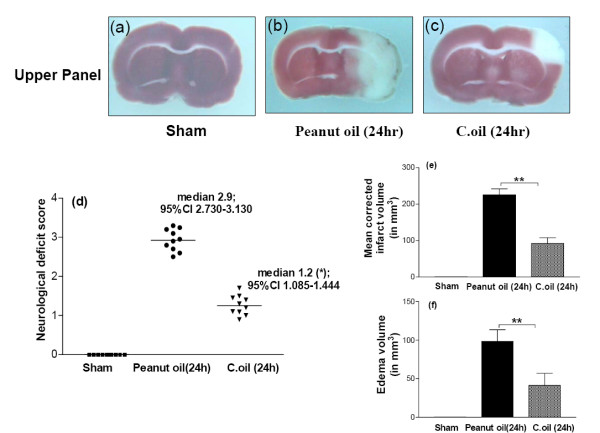Figure 4.
Effect of C.oil given 4 hrs after ischemia and evaluation were made after 24 hrs of ischemia. After 24 hrs sham-operated, peanut oil treated ischemic group and C.oil post treated group of rats were evaluated for neurological deficit thereafter rats were euthanized and infarct and edema volume were calculated. Upper panel showing the representative photograph of TTC stained coronal section from brain sham-operated (a), peanut oil treated ischemic and (b) C.oil treated after ischemia (c). Number of animals used was ten in each group. Bar graph (d): Neurological evaluation scores of rats from sham-operated, peanut oil and C.oil post-treatment ischemic groups at 24 hrs are shown in scattergram. The line demarcates the median. *P < 0.05 was considered significant when comparisons were made with the peanut oil treated ischemic group by Non parametric Kruskal-Wallis test followed by Dunn's Multiple Comparison Test. Bar graph (e): The bar chart showing the brain infarct volume after 24 hrs from sham-operated, peanut oil treated ischemic and C.oil post-treatment ischemic. Data are expressed as mean ± S.E.M. P < 0.001 was considered highly significant when comparisons were made with the peanut oil treated ischemic group by one way ANOVA followed by Newman Keuls post hoc test. Bar graph (f): Effect of post-treatment of C.oil on edema volume after 24 hrs of ischemia. Data are expressed as mean ± S.E.M. of ten animals each group. P < 0.001 was considered significant when comparisons were made with the peanut oil treated ischemic group by one way ANOVA followed by Newman Keuls post hoc test.

